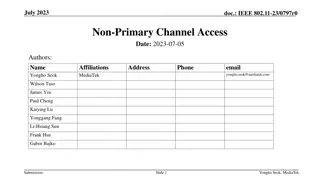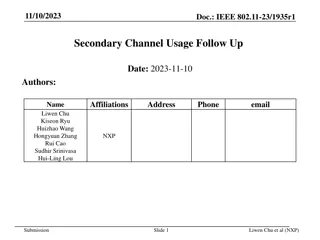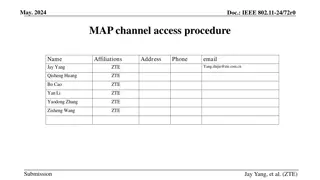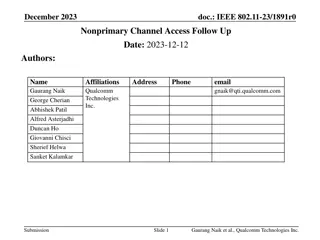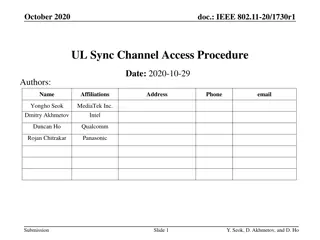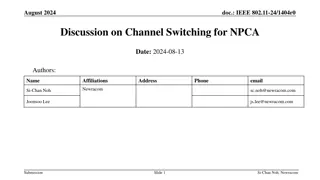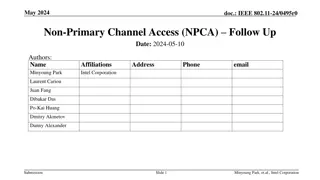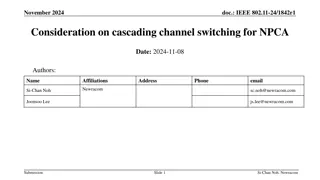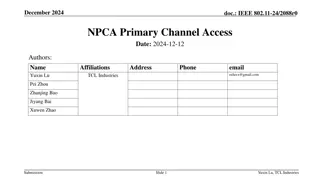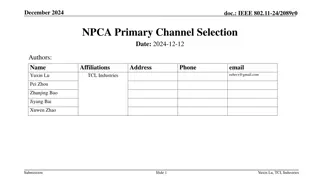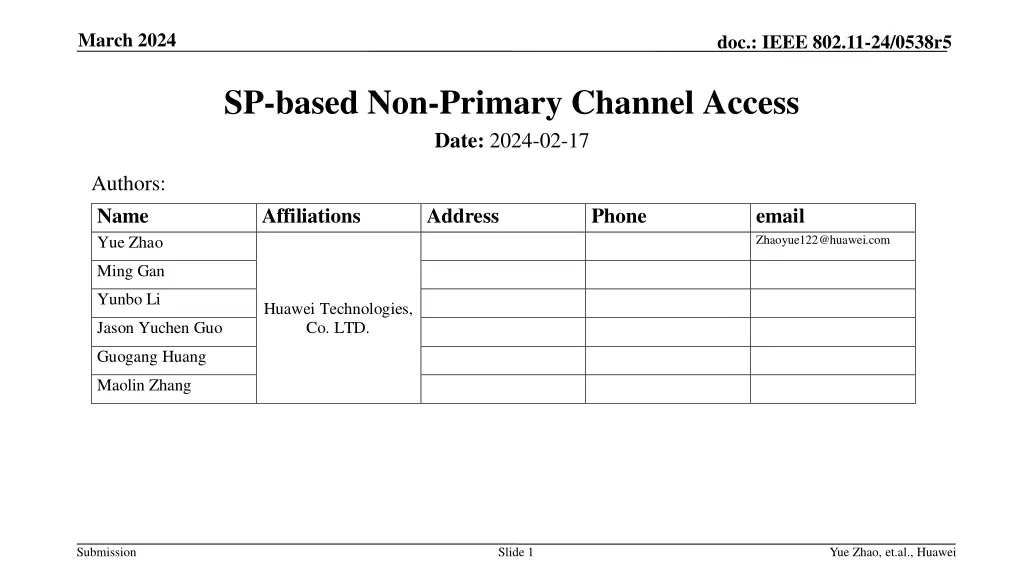
Enhancing Wi-Fi Performance with SP-based Non-Primary Channel Access
Explore how SP-based Non-Primary Channel Access improves channel efficiency in Wi-Fi networks, addressing issues with primary channel congestion during heavy traffic periods. This method optimizes channel switching to non-primary channels, providing insights into reducing collisions and enhancing network performance.
Download Presentation

Please find below an Image/Link to download the presentation.
The content on the website is provided AS IS for your information and personal use only. It may not be sold, licensed, or shared on other websites without obtaining consent from the author. If you encounter any issues during the download, it is possible that the publisher has removed the file from their server.
You are allowed to download the files provided on this website for personal or commercial use, subject to the condition that they are used lawfully. All files are the property of their respective owners.
The content on the website is provided AS IS for your information and personal use only. It may not be sold, licensed, or shared on other websites without obtaining consent from the author.
E N D
Presentation Transcript
March 2024 doc.: IEEE 802.11-24/0538r5 SP-based Non-Primary Channel Access Date: 2024-02-17 Authors: Name Yue Zhao Affiliations Address Phone email Zhaoyue122@huawei.com Ming Gan Yunbo Li Huawei Technologies, Co. LTD. Jason Yuchen Guo Guogang Huang Maolin Zhang Submission Slide 1 Yue Zhao, et.al., Huawei
February 2024 doc.: IEEE 802.11-24/0538r5 Motivation To meet throughput and latency requirements mentioned in the UHR PAR [1], non- primary channel access (NPCA) was proposed as a potential method Existing Techs: Many contributions [2] focus on TXOP-based NPCA To switch to a non-primary channel when OBSS TXOP is detected on the primary channel To switch back to the primary channel when OBSS TXOP on the primary channel ends Reality: OBSSs often use the same primary channel, if the operating channels overlap Heavy traffic is anticipated during TWT SPs => Primary channel becomes very busy during an OBSS TWT SP Frequent switching is anticipated during OBSS TWT SPs Wherein durations on the primary channel might be too shattered to be used => SP-based NPCA is introduced Submission Slide 2 Yue Zhao, et.al., Huawei
February 2024 doc.: IEEE 802.11-24/0538r5 Recap: TXOP-based NPCA With a wider operating channel width and a denser network deployment, channel efficiency is low when only the primary channel access is used With only primary channel access, a STA has to do backoff for transmission if the primary channel is busy, even when non-primary channels are idle. With TXOP-based NPCA, when the primary channel is occupied by an OBSS TXOP, STAs switch to a non-primary channel to contend for the channel, using idle non-primary channels to access the medium, and switch back to the primary channel when the OBSS TXOP ends. BSS TXOP Non-primary channel Switch back to the primary channel Switch to a non-primary channel OBSS TXOP Primary channel Submission Slide 3 Yue Zhao, et.al., Huawei
February 2024 doc.: IEEE 802.11-24/0538r5 Concept: SP-based NPCA With SP-based NPCA, a BSS switches to a non-primary channel to access the medium during an OBSS TWT SP and switches back when SP ends, because It is anticipated that there would be heavy traffic during the TWT SPs OBSSs with staggered parking channels reduce collisions [3] frequency Non-primary channel BSS parking BSS parking Primary channel OBSS TWT SP BSS parking OBSS TWT SP BSS parking time BSS parking Non-primary channel OBSS TWT SP Primary channel Submission Slide 4 Yue Zhao, et.al., Huawei
February 2024 doc.: IEEE 802.11-24/0538r5 Proposal Negotiation Phase: AP and non-AP STAs negotiate parameters used in SP-based NPCA phase Parked non-primary channel, etc. SP-based NPCA Phase: AP and non-AP STAs park on the non-primary channel during OBSS TWT SPs, and park on the primary channel outside OBSS TWT SPs SP-based NPCA Phase Negotiation Phase OBSS TWT SP OBSS TWT SP Non-primary channel BSS parks BSS parks AP announces OBSS TWT Info Primary channel Negotiation Note: Not parked on the subchannel Submission Slide 5 Yue Zhao, et.al., Huawei
February 2024 doc.: IEEE 802.11-24/0538r5 Detail 1. SP-based NPCA Phase For each OBSS TWT Info detected by AP Step 1. AP announces an OBSS TWT Info Step 2. AP and non-AP STAs in a BSS, park on a non-primary channel instead of the primary channel only during OBSS TWT SPs AP and non-AP STAs in a BSS automatically switch to the non-primary channel when an SP starts and automatically switch back to the primary channel when an SP ends OBSS TWT SP BSS parking Non-primary channel Switches back to the primary channel BSS parking BSS switches to a non-primary channel BSS parking AP announces OBSS TWT Info Primary channel Submission Slide 6 Yue Zhao, et.al., Huawei
February 2024 doc.: IEEE 802.11-24/0538r5 Detail 1-1. AP s Announcement of OBSS TWT AP collects OBSS TWT Info via, e.g., Listening to OBSS s beacon, or Information exchange among multiple APs (Multi-AP co-operation) OBSS TWT Info is announced/broadcasted by AP via, e.g., Modified current TWT element, or Defined OBSS TWT element Submission Slide 7 Yue Zhao, et.al., Huawei
February 2024 doc.: IEEE 802.11-24/0538r5 Discussion Non-supporting UHR non-APs compatibility Option 1: the feature can be enabled only when there is no non-supporting UHR non-Aps Option 2: need additional rules to regularize behaviour for UHR STAs when not supporting the feature Legacy compatibility Option 1 [Preferred]: the feature can be enabled only when there is no pre-UHR associated non-APs Simple on AP s scheduling implementation Option 2: for particular pre-UHR features, e.g., trigger-enabled TWT, quite procedure, the proposed feature can be enabled only when all pre-UHR associated non-APs support those particular pre-UHR features Submission Slide 8 Yue Zhao, et.al., Huawei
February 2024 doc.: IEEE 802.11-24/0538r5 Discussion (Cont.) Location of NPCA operating channel Case 1: Bandwidth of MyBSS is larger than the Bandwidth of OBSS Option 1 [Preferred]: MyBSS uses secondary channels which do not overlap with the OBSS operating channel Option 2: MyBSS uses the whole operating channel but the NPCA (temporary) primary channel is a secondary channel which do not overlap with the OBSS operating channel Case 2: Bandwidth of MyBSS is less than or equal to the Bandwidth of OBSS Option 1 [Preferred]: MyBSS switches to a temporary operating channel outside of current operating channel, and the temporary operating channel does not overlap with the OBSS operating channel Option 2: MyBSS uses the current operating channel but the NPCA (temporary) primary channel is a secondary channel Preference is to minimize the impact (e.g., interference, bandwidth changing) on OBSS. Submission Slide 9 Yue Zhao, et.al., Huawei
February 2024 doc.: IEEE 802.11-24/0538r5 Discussion (Case 1) Secondary X MHz Secondary X MHz BSS BSS Primary X MHz OBSS Primary X MHz OBSS PC PC During SP During SP NPC NPC BSS Secondary X MHz Secondary X MHz BSS Primary X MHz OBSS Primary X MHz OBSS PC PC Option 2 Option 1 [Preferred] Submission Slide 10 Yue Zhao, et.al., Huawei
February 2024 doc.: IEEE 802.11-24/0538r5 Discussion (Case 2) Secondary X MHz Secondary X MHz Primary X MHz OBSS Primary X MHz BSS OBSS BSS PC PC During SP During SP NPC BSS Secondary X MHz Secondary X MHz NPC OBSS BSS Primary X MHz Primary X MHz OBSS PC PC Option 2 Option 1 [Preferred] Submission Slide 11 Yue Zhao, et.al., Huawei
February 2024 doc.: IEEE 802.11-24/0538r5 Discussion (Cont.) During respected r-TWT SP OBSS: following base line BSS: regular EDCA After the respected r-TWT SP Medium sync recovery is needed for AP and non-AP STAs in BSS Submission Slide 12 Yue Zhao, et.al., Huawei
February 2024 doc.: IEEE 802.11-24/0538r5 Discussion (Cont.) Negotiation necessity between MyBSS and OBSS Option 1: MyBSS respects (switches to non-primary channel) without notice of OBSS Option 2 [Preferred]: Negotiation is needed to determine which OBSS TWT is to be respected and which is not OBSS sends a request to be respected during an OBSS r-TWT schedule and BSS responds Necessary r-TWT and SP-based NPCA related parameters are exchanged during negotiation BSS is allowed to reject Submission Slide 13 Yue Zhao, et.al., Huawei
February 2024 doc.: IEEE 802.11-24/0538r5 Summary The idea of SP-based NPCA is introduced: A BSS parks on a non-primary channel during OBSS TWT SPs AP and non-AP STAs in the BSS switch to the non-primary channel when an OBSS TWT SP starts, and switch back to the primary channel when the OBSS TWT SP ends Submission Slide 14 Yue Zhao, et.al., Huawei
February 2024 doc.: IEEE 802.11-24/0538r5 Straw Poll Do you support to include SP-based NPCA where a BSS parks on a non- primary channel during OBSS TWT SPs in 11bn SFD? Do you agree that UHR APs may negotiate r-TWT schedule(s) that enable one AP and its associated STAs switch from the BSS operating channel to a different channel during the r-TWT schedule(s) of the other AP? Submission Slide 15 Yue Zhao, et.al., Huawei
February 2024 doc.: IEEE 802.11-24/0538r5 References [1] 11-23/0480r3, UHR proposed PAR, Laurent Cariou [2] 11-23/2005r1, Non-primary channel access (NPCA), Minyoung Park [3] 11-23/2022r1, R-TWT for multi-AP (follow-up), Laurent Cariou Submission Slide 16 Yue Zhao, et.al., Huawei



